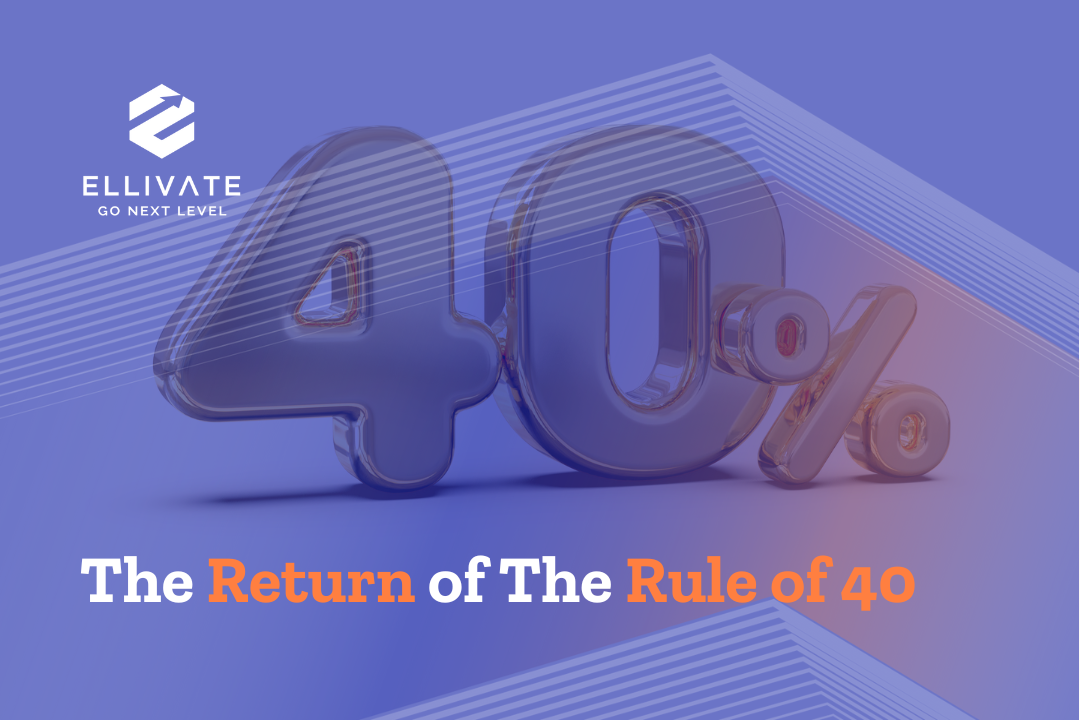As a SaaS company matures, a management team must focus on operational discipline to generate strong shareholder returns.
Let’s find out how the rule of 40 can help a company’s profitability.
What is the rule of 40?
The rule of 40 is a financial performance metric that suggests that for a company to be doing well, it should have a combined growth rate and profit margin of over 40 per cent.
The rule is popular among venture capitalists and growth equity investors as it provides a quick way to measure a company’s performance.
Recently there have been several high-profile organisations that have failed in Australia, and this has primarily been due to them not generating the required investment. FinTechs such as Vault and grocery delivery app Send have closed their doors due to their losses. The current global market has meant investors are shifting focus from hyper-growth at all costs to sustainable, profitable growth, and that’s where the rule of 40 comes in.
There are a few different ways to calculate the rule of 40. The most common method is adding the current year’s revenue growth rate and net income margin. However, some people also include gross profit margin in the calculation.
The rule can be a valuable tool for investors and management teams alike. It can help indicate whether a company is on track to achieve its goals, and it can also help identify areas where improvement is needed.
While there are some exceptions to the rule of 40 (companies with high initial investment costs), it remains a useful metric for investors and analysts.

Long-term implementation of the rule
This means that a team must be diligent in executing the company’s core strategies and maintaining tight control over costs. Additionally, they must be able to adapt the business model as needed to keep up with changes in the market.
While this can be a challenge, it is essential for ensuring that the company remains successful over the long term.
The rule of 40 has been used for decades by public companies and private venture capital firms alike. Using this formula, you can assess how much revenue your business must generate each year before achieving profitability on an FTE basis.
Introducing this simple benchmark helps ensure that your business remains focused on growth and profitability.
As a high-level health check in SaaS companies, the concept gained popularity and momentum in the software industry. Growth equity firms and VCs use it to gauge the costs and benefits of various strategies for achieving optimal growth.
Key metrics for evaluating a company’s performance
Growth and profitability are crucial to evaluating a company’s performance. Growth is not enough to justify a valuation, though. In fact, many companies with fast growth can’t make money or don’t have much of it.
Profitability is key to building a sustainable business—and it’s also important for founders who want to create long-term value and wealth for themselves and their investors.
Though, there are some start-ups where growth comes first (Uber) or where profitability isn’t even on the table at all (Airbnb).
When we talk about this topic broadly, we’d all agree that most start-ups won’t survive unless they figure out how to make money from their users sooner rather than later.
The rule of 40 in today’s SaaS start-ups & scale-up businesses
Let’s take a closer look at the rule of 40 and how it applies to SaaS start-ups and scale-up businesses.
As you may know, SaaS companies typically recognise revenue on a subscription basis. That is, revenue is recognised over the life of the contract rather than when the services are delivered. This accounting treatment has a few important implications.
First, it means that SaaS companies must have strong recurring revenue to succeed.
Second, it means that SaaS companies must carefully manage their customer churn rate.
If too many customers cancel their subscriptions, it will hurt the company’s bottom line.
The rule of 40 states that a company will become profitable if its monthly recurring revenue (MRR) exceeds its annual operating costs (OpCost) divided by twelve, by at least 40%.
This simple rule provides a quick way to assess whether a company is on track to become profitable.

Why is the rule of 40 more relevant today than ever before?
The answer is that growth and profitability are key to evaluating a company’s performance. VCs are becoming more selective, competition is increasing, and investors are looking for companies that can scale and grow profitably.
As we have seen in earlier sections, the rule of 40 identifies whether a company has achieved product-market fit (PMF) or not, i.e., what your customers want and how much they will pay for it.
Defining a path to profitability
If you have high growth in your business but don’t see any profit, then this is not good. Your investment may be risky without any return on investment (ROI).
On the other hand, if you have low growth but show profitability, this indicates that something must be wrong with your business model or product/service offering.
That is why the rule of 40 is a very powerful tool. It allows start-ups and scale-ups to define their path toward profitability and evaluate whether their performance is healthy.
How will investors and VCs slowdown force businesses to change
During the recession, most venture capital firms became much more cautious with their investments. They were willing to wait for growing companies to become profitable and prove that their business model worked before committing significant funding.
While there were some exceptions, this approach has become the norm in Silicon Valley. To make sure they don’t lose out on start-ups that can be profitable, many VCs are looking for more than just growth from founders.
They want entrepreneurs who have already achieved some level of success with customers or revenue before asking for money.
This is especially true if a start-up is seeking Series A funding—the first round of venture capital after seed capital has been raised, where start-ups typically need large amounts of cash. They have been around long enough to prove themselves but not so long that they’ve lost all sense of urgency or risk-taking (at least in theory).
Many start-ups will need to find new ways to get funding if they’re going through rapid growth, and the only way to do that is to focus on profitability. In other words, they’ll need to hit the rule of 40.

Conclusion
As we’ve discussed, the SaaS market is changing. This means that start-ups must take a new approach to growth and profitability.
The rule of 40 is a simple financial performance metric that allows companies to measure whether they are performing well. It also helps them plan for future growth by giving them visibility into what it takes to become profitable at different levels of revenue growth.
If you want to learn more about the rule of 40 or implement strategies to drive profitable growth in your business, contact us today and let us show you what we can do.




